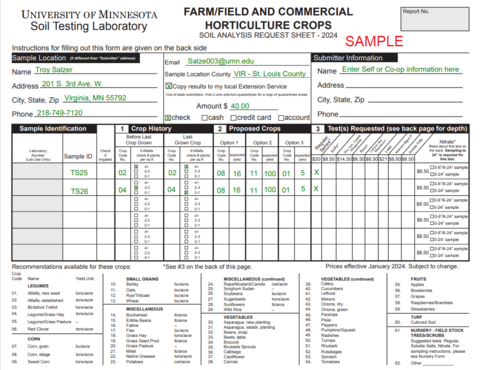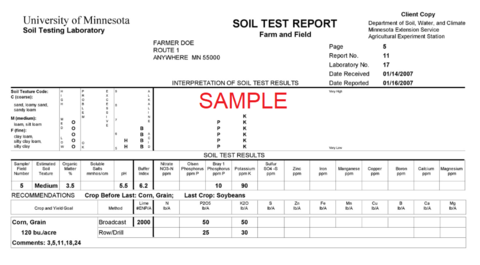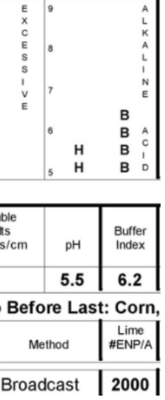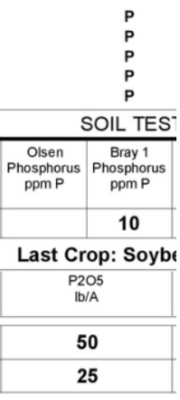Let's take a deeper look into and provide more information about soil sampling. We will cover why you should consider, how to collect, how to submit, and how to interpret a soil sample submission.
Why should I test my soil?
Soil testing helps to identify nutrient-related issues, allowing for strategic and efficient application of nutrients for crop growth and reducing the potential for over or under-application, thus minimizing cost and environmental risk.
How often should I submit a soil sample?
It is recommended to perform a soil test on a field every four years or to diagnose nutrient-related plant growth issues.
What does a soil sample test?
The regular series tests phosphorus, potassium, pH, % organic matter, and estimated texture. Additional tests can be requested for nitrogen or other micronutrients.
Collecting a soil sample
Using a shovel or soil probe, dig a hole or probe at least 6 inches of soil depth. Place the subsample into a bucket or container. Collect 12-15 subsamples for a field and 4-6 for a garden. For an accurate soil sample, aim to take the same amount of soil from each sampling location. Thoroughly mix the subsamples together. Place 2 cups of composite sample into a well-labeled bag. Ship or deliver to the soil testing lab with the sample submission form.
Submitting a soil sample
The required submission form has been shared below but can be found in a printable format on the website. More information about properly submitting soil samples and the submission forms can be found on the Soil Testing Laboratory website.
Soil samples can be placed in Soil Testing Laboratory sample bags (available at University of Minnesota Extension offices) or placed into well-labeled plastic bags/containers. Note that containers will not be returned.
A flat-rate box or poly mailer should be used to keep all components in a sample submission together for mailing. Composite samples, Soil Submission Forms, and payment can be shipped or delivered to Soil Testing Lab.
Mail or deliver completed samples to the Soil Testing Laboratory: UMN Soil Testing Laboratory 135 Crops Research Building 1902 Dudley Avenue St. Paul, MN 55108
Understanding a farm and field soil sample result
A farm and field result can be viewed in a similar manner to a lawn and garden result, but recommendations are given in terms of lbs./acre instead of lbs./1000 sq foot.
If you have any questions related to the interpretation of a yard and garden soil sample, reach out to your Extension educator via the Horticulture Phone Line at (218) 733-2870 and press 2 to leave a message.
One critical thing about the results is to understand the organic level, if below 5-6%, add organic matter. Peat, yard compost, manure compost, and cover crops (green manure) may be added to increase organic matter.
If the pH range is outside of 6-7, pH modification may be recommended. This can be done with the addition of lime if the soil has low pH, or sulfur if the soil has high pH.
For a short-term fix, the use of ammonium sulfate as a nitrogen source will also reduce the pH. Then, look at phosphorus and potassium to follow recommendations.
Nitrogen drives plant growth and is often the most limiting nutrient. Residual nitrogen is available and is calculated for the results based on organic matter concentrations.
Leafy green crops and sweet corn will often require nitrogen application. When applying nitrogen, till down and top dress beds. Utilize the percentages of nutrients on the label to determine the amount of nitrogen (N), phosphorus (P), and potassium (K) to apply.
Nutrients are listed on the label in the order N-P-K depending on the percentage in the mixture.
Interpretation of Field Soil Testing Results
Texture indicates the soil's ability to maintain moisture, hold nutrients, and impact water infiltration. The texture will also play a role in the soil's CEC, the ability to hold nutrients. This is based on the soil's parent material and cannot be adjusted.
Organic Matter Organic matter acts as the sponge to hold water and nutrient and is related to the amount of carbon in the soil. Organic matter is indicated by the percentage in the soil. In the scale above the percentage, the higher number of symbols on the scale indicates higher concentrations in the soil. Cover crops may be integrated to increase organic matter.
Ideal pH for most agronomic crops is 6.5-6.9. If below or above that range, it reduces the availability to other nutrients for uptake. Below this range, a soil is considered acidic, and above it is considered basic. Lime products are frequently used to correct low pH soil. Buffer index indicates the ease at which to change the pH of a particular soil. This is impacted by soil texture and your organic matter concentration. Utilizing buffer index will increase your efficiency at hitting your final target pH with lime application.
In this case, the results indicate a need for 2000 ENP/A (Effective Neutralizing Power per Acre), a number provided by a supplier. If a retailer has a product supplying 1000 ENP/A, it will require 2-ton product per acre.
Phosphorus is a nutrient that provides structure within the cells and energy transport within the plant. Phosphorus is the nutrient most substantially impacted by pH, making it less available outside of the ideal range (6.5-6.9). Phosphorus is tested using the Bray process when pH is below 7.2, and the Olsen process when pH is above 7.2. This better indicates the phosphorus availability within range. Results are given in the form of parts per million of Phosphorus. These recommendations are given in the form of pounds per acre of phosphorus for the crop and yield goal indicated. Information for additional crops can be looked up in the Fertilizer Guidelines for Agronomic Crops in Minnesota. It is recommended to apply phosphorus in the form of DAP (Diammonium phosphate), MAP (Monoammonium phosphate), or Superphosphate (Tri ammonium phosphate). Each of these sources contains different concentrations of phosphorus; therefore, a conversion must be completed to determine how much product is required to get the desired amount for application.
Potassium is critical for reproduction, grain or fruit production, and structure. Results are given in the form of parts per million of Potassium. Potassium is derived most commonly in the form of myriad potash and potassium sulfate. Recommended potassium application is provided in pounds per acre for the specified crop. Information for additional crops can be looked up in the Fertilizer Guidelines for Agronomic Crops in Minnesota. Concentration conversion will be necessary in order to apply the required amount of potassium.
It is important to remember that the soil test results are measuring the nutrient availability at the time the test was taken. Based on this fact, we recommend taking your soil test every time during the same season due to biological activity and to maintain the value of comparison.
In the case of the farm field results, the lab provides a recommendation based on the crop and yield goal you suggested. If you did not include a crop, they will provide a general recommendation based on what is common in your area. Now I would suggest using the information to refine your recommendation based on the crop and realistic yield goal in your area. If you are interested in using your soil test results and would like to look up the specific requirements of any Agriculture crop grown in Minnesota please uses "Fertilizer Guidelines for Agronomic Crops in Minnesota" handbook.
https://extension.umn.edu/nutrient-management/crop-specific-needs
https://soiltest.cfans.umn.edu/testing-services/farmhorticultural-field
https://extension.umn.edu/nutrient-management/crop-specific-needs








